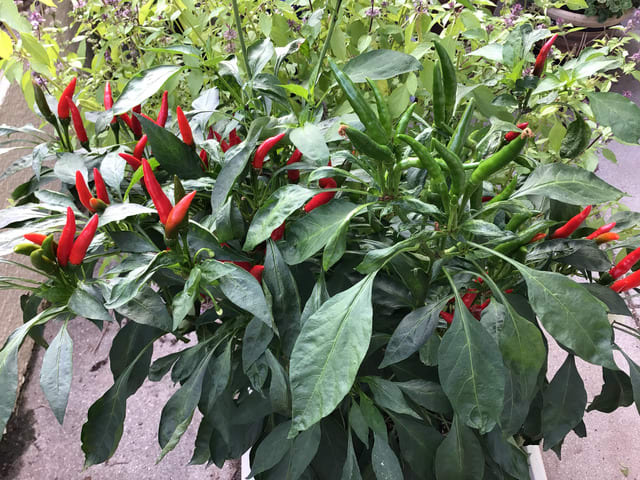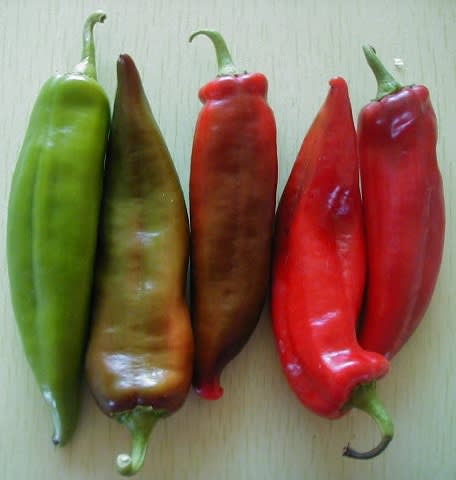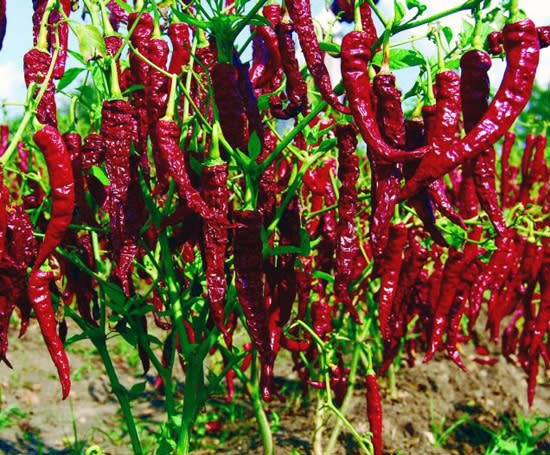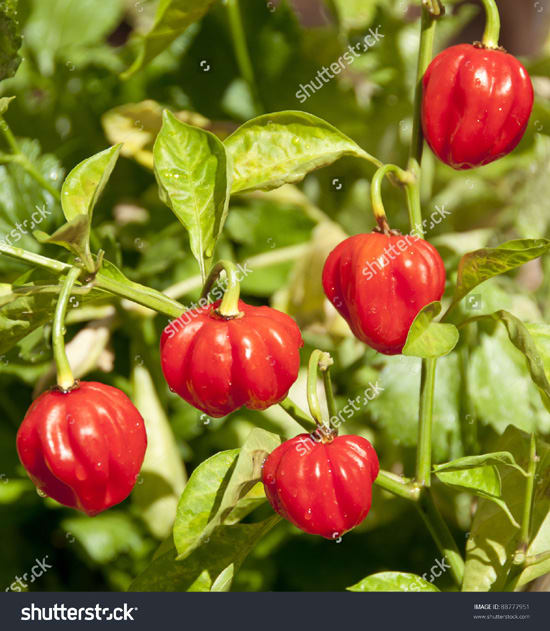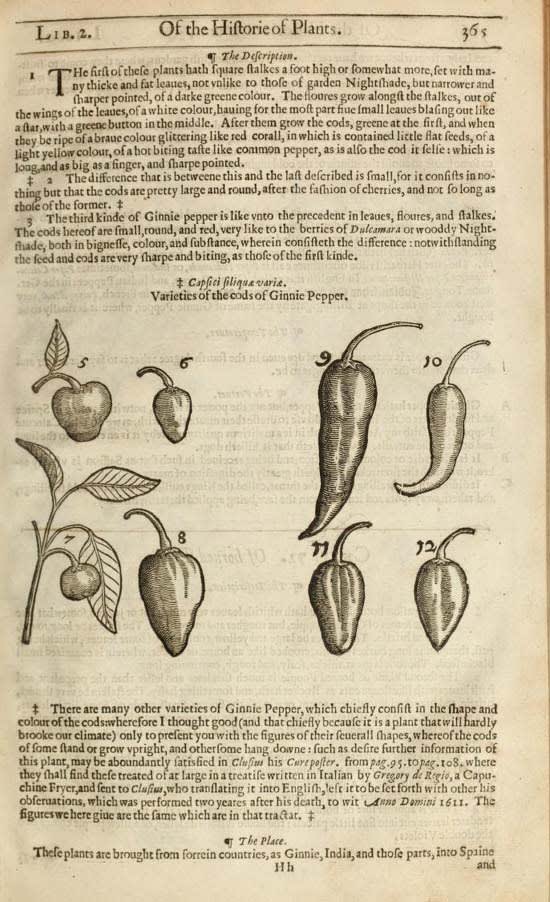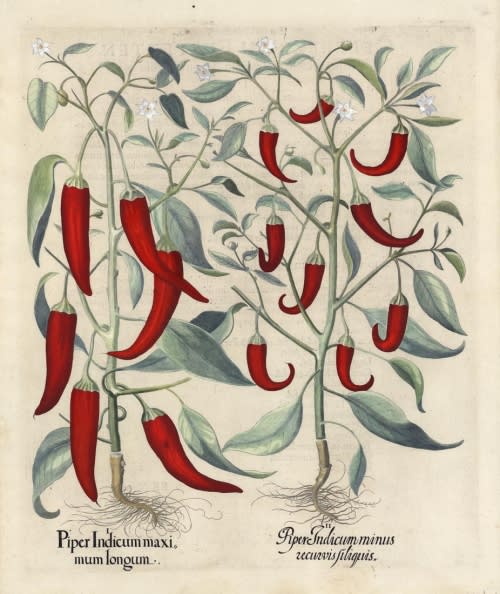|
|
GUINEA PEPPER
Names. Called also cayanne pepper and bird pepper.
Description. There are several kinds. In general it grows with an upright, firm, round stalk, with a certain pith within it, about two or three feet high spreading into many branches on all sides, from the very bottom, which divide themselves again into other smaller branches at each joint whereof come two long leaves upon short footstalks, somewhat bigger than those of nightshade, with several veins, not dented about the edges, and of a dark green colour: the flowers stand severally at the joints, with leaves like the flowers of nightshade, consisting most usually of five, and sometimes six, white small-pointed leaves, standing open like a star, with a few yellow threads in the middle, after which come the fruit, either great or small, long or short, round or square, as the kind is, either standing upright or hanging dwn, as their flowers shew themselves either of this or that form: the seeds are very numerous, kidney-shaped, and a little compressed: the root annual and fibrous, spreading plentifully in the ground, but perishing, even in hot countries, after it has ripened all its fruits.
Place. It is a native of the Indies, but will bear the air of our climate, and ripens its fruit with us if brought forward in a hot bed in the spring, and afterwards planted out in the open ground.
Time. They do not sow it in hot countries before the end of March or beginning of April, and at the soonest they do not flower before August following, and their red pods ripen not thoroughly until November, when they will continue both with flowers and fruit most of the winter, where the weather is not very intense; but in very cold climates they perish with the first frost, and therefore must be carefully housed in order to be preserved.
Government and virtues. All kinds of guinea pepper are under Mars, and are of a fiery, sharp, biting taste, and of a temperature hot and dry, to the end of the fourth degree; they burn and inflame the mouth and throat so extremely that it is hard ot be endured, and if it be outwardly applied to the skin in any part of the body, it will exulcerate and raise it as if it had been burnt with fire, or scalded with hot water. The vapours that arise from the husks or pods, while a person opens them to take out the seed, (especially if he beats them into powder, or bruises them) will so pierce the brain by flying up into the head through the nostrils, as to produce violent sneezings, and draw down abundance of thin rheum, forcing tears from the eyes, and will pass into the thoat, adn provoke a sharp coughing, and cause violent vomiting; and if any shall with their hands touch their face or eyes, it will cause so great an inflammation that it will not be remedied in a long time by all the bathing thereof with wine or cold water that can be used, but yet will pass away without further harm. If any of it be caste into fire, it raises grievous strong and noisome vapours, occasions sneezing, coughing, and stron vomiting to all that be near it; if it should be taken simply of itself (though in very small quantity, either in powders or decoction) it would be hard to be endured, and might prove dangerous to life. Such are the dangers attending the immoderate use of these violent plants and fruits; yet, when corrected of their evil qualities, they are of considerable service. Take the ripe pods of any sort of the guinea-pepper, (for they are in property all alike) and dry them well, first of themselves, then in an oven, after the bread is taken out: put it into a pot or pipkin, with some flower, that they may be quick dried; then cleanse them from the flour and their stalks, if they have any; cut both husks and seeds within them very small, and to every ounce of them put a pound of wheat flour: make them up together into cakes or small loaves, with leaven proportioned to the quantity you make; bake these as you do bread of the small size, and when baked, cut it again into smaller parts and thin; bake it again that it may be as dry and hard as a biscuit, which beaten into fine powder and sifted, may be kept for any of the uses hereafter mentioned, or may serve instead of ordinary pepper to season meat or broth for sauce, for it not only gives it a good taste or relish, but tends to discuss the wind and cholic in the body. It is of singular service to be used with flatulent or windy diet, and such as breeds moisture and cridities; one scruple of the said powder, taken in a little broth of veal or of a chicken, gives great relief and comfort to a cold stomach, causing phlegm and such viscous humours as lie low in the bottom thereof, to be voiced: it helps digestion, for it occasions an appetite to meat, provokes urine, and taken with saxifrage water expels the stone in the kidnies, and the phlegm that breeds it, and takes away dimness or mistiness in the sight, being used in meats. Taken with pillulæ aleophanginæ, it helps the dropsy: the powder, taken for three days together in the decoction of penny-royal, expels the dead birth, but if a piece of the pod or husk, either green or dry, be put into the womb after delivery, it will make them barren for ever after; but the powder, taken for three or four days fasting, with a little fennel seed, will ease all the pains fo the mother. The same also made up with a little powder of gentian and oil of bays, into a pessary, with some cotton wool, brings down the courses: and the same mixes very well with an electuary, for the cough, helps an old inveterate cough; being mixed with honey, and applied to the throat, it helps the quinsey; and made up with a little pitch or turpentine, and laid upon any hard knots or kernels in any part of the body, it will dissolve them, and not suffer any more to grow there; and being mixed with nitre, and applied, it takes away the morphew and all freckles, spots, marks, and discolourings of the skin; applied with hen's grease, it dissovles all cold imposthumes and carbuncles, and mixed with sharp vinegar dissolves the hardness of the skin; mixed with unguentum de alobastro, and the reins of the back anointed therewith, it will take away the shaking fits of agues; a plaister made therof with the leaves of tobacco, will heal the sting or biting of any venomous beast or animal. The decoction of the husks themselves, made with water, and the mouth gargled therewith, helps the tooth-ach, and preserves the teeth from rottenness; the ashes fo them being rubbed on the teeth, will cleanse them, and make them look white. The decoction of them in wine helps the hernia ventosa, or watery rupture, if applied warm morning and evening. If put to steel for three days together in aqua vita, it helps the palsy, the place affected being bathed therewith: and steeped for a day in wine, and two spoonfuls drank thereof every day, fasting, it is of singular service in rendering stinking breath sweet.
It is sometimes given as one of the highest stimulants in cold sluggish phlegmatic disorders, in paralytic complaints, in relaxations of the stomach, and for promoting the efficacy of aloetic and nervous medicines, and in hysteric and other female diseases.
A little of the pulpy part of the fruit, held in the mouth, cures the tooth-ach; and if bruised and applied externally to the part affected, in form of a poultice, with the addition of crumbled bread and honey, enough to bring it to a proer consistence, it is good for the quinsey.

Guinea pepper =: Piper indicum
Alternate Title(s): Piper indicum
Author(s):
Blackwell, Elizabeth, active 1737., engraver
Subject(s): Capsicum
Extent: 1 print : 37 x 25 cm.
Technique: etching and engraving, hand-colored
Permanent Link: http://resource.nlm.nih.gov/101456760
|
